Citroen C4 PICASSO 2016 2.G Owner's Manual
Manufacturer: CITROEN, Model Year: 2016, Model line: C4 PICASSO, Model: Citroen C4 PICASSO 2016 2.GPages: 527, PDF Size: 13.72 MB
Page 311 of 527
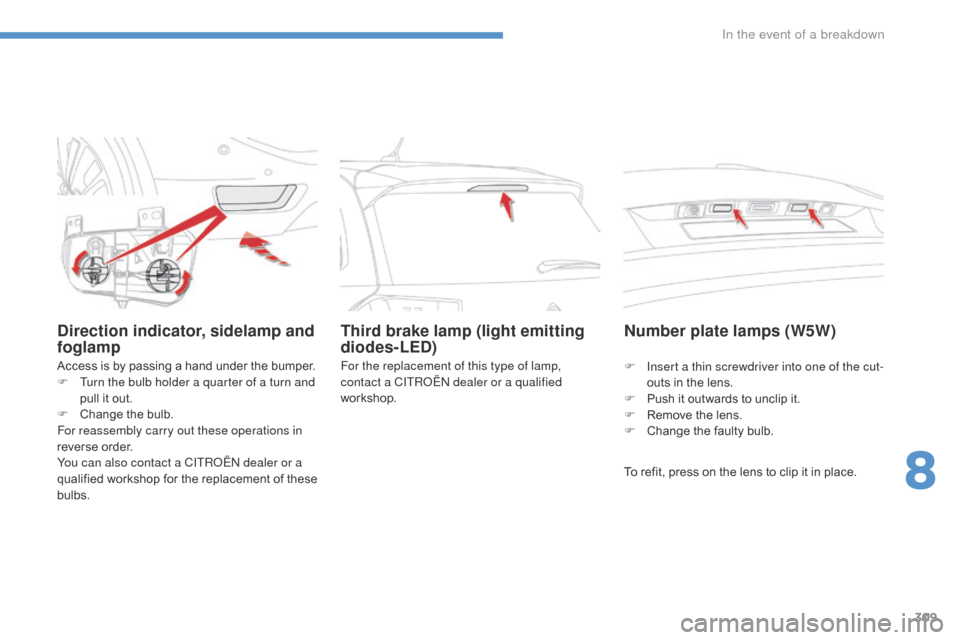
309
C4-Picasso-II_en_Chap08_en-cas-panne_ed01-2016
Direction indicator, sidelamp and
foglamp
Access is by passing a hand under the bumper.
F T urn the bulb holder a quarter of a turn and
pull
it out.
F
C
hange the bulb.
For reassembly carry out these operations in
reverse
o
rder.
You can also contact a CITROËN dealer or a
qualified
workshop for the replacement of these
b
ulbs. For the replacement of this type of lamp,
contact a CITROËN dealer or a qualified
workshop.
Third brake lamp (light emitting
diodes-LED)
Number plate lamps (W5W)
To refit, press on the lens to clip it in place.
F
I
nsert a thin screwdriver into one of the cut-
outs in the lens.
F
P
ush it outwards to unclip it.
F
R
emove the lens.
F
C
hange the faulty bulb.
8
In the event of a breakdown
Page 312 of 527
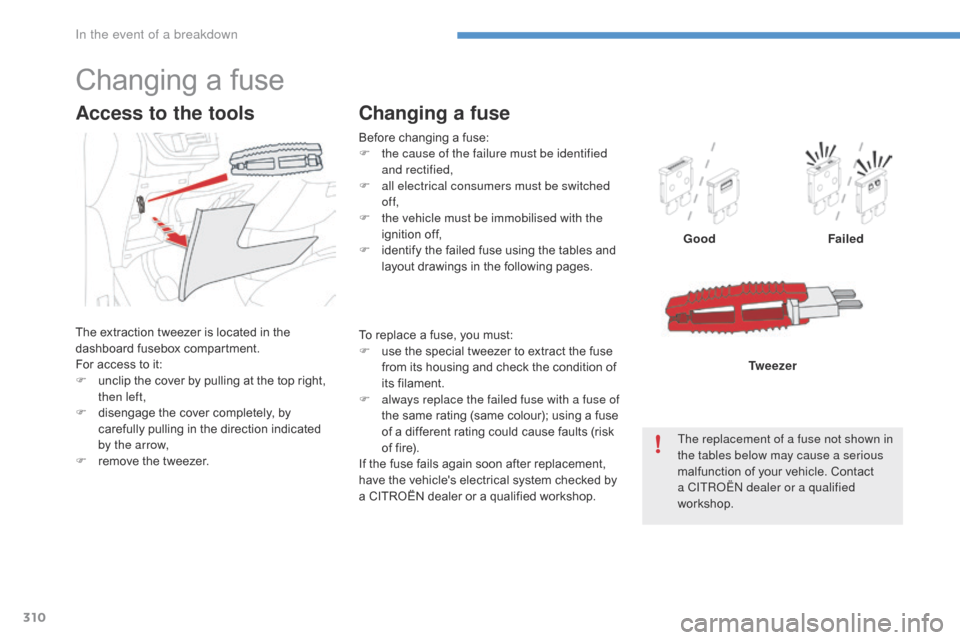
310
C4-Picasso-II_en_Chap08_en-cas-panne_ed01-2016
Before changing a fuse:
F t he cause of the failure must be identified
and rectified,
F
a
ll electrical consumers must be switched
of f,
F
t
he vehicle must be immobilised with the
ignition
o
ff,
F
i
dentify the failed fuse using the tables and
l
ayout drawings in the following pages.
Changing a fuse
GoodFailed
The replacement of a fuse not shown in
the tables below may cause a serious
malfunction
of your vehicle. Contact
a C
ITROËN dealer or a qualified
workshop. Tw e e z e r
Changing a fuse
The extraction tweezer is located in the d
ashboard f usebox c ompartment.
For
access to it:
F
u
nclip the cover by pulling at the top right,
t
hen left,
F
d
isengage the cover completely, by
c
arefully pulling in the direction indicated
b
y the arrow,
F
r
emove the tweezer.
Access to the tools
To replace a fuse, you must:
F u se the special tweezer to extract the fuse
f
rom its housing and check the condition of
it
s
f
ilament.
F
a
lways replace the failed fuse with a fuse of
the
same rating (same colour); using a fuse
o
f a different rating could cause faults (risk
o
f fire).
If
the fuse fails again soon after replacement,
h
ave the vehicle's electrical system checked by
a
CITROËN dealer or a qualified workshop.
In the event of a breakdown
Page 313 of 527
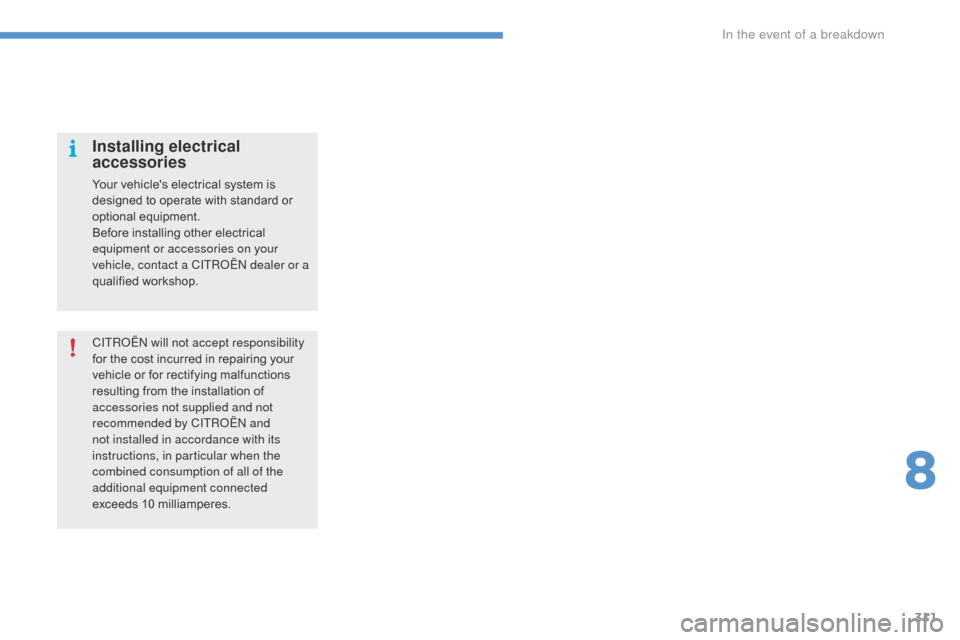
311
C4-Picasso-II_en_Chap08_en-cas-panne_ed01-2016
CITROËN will not accept responsibility
for the cost incurred in repairing your
v
ehicle or for rectifying malfunctions
r
esulting from the installation of
a
ccessories not supplied and not
recommended by CITROËN and
not installed in accordance with its
instructions, in particular when the
combined consumption of all of the
additional equipment connected
exceeds
1
0
mil
liamperes.
Installing electrical
accessories
Your vehicle's electrical system is designed to operate with standard or
o
ptional
e
quipment.
Before
installing other electrical
e
quipment or accessories on your
vehicle, contact a CITROËN dealer or a
qualified
w
orkshop.
8
In the event of a breakdown
Page 314 of 527
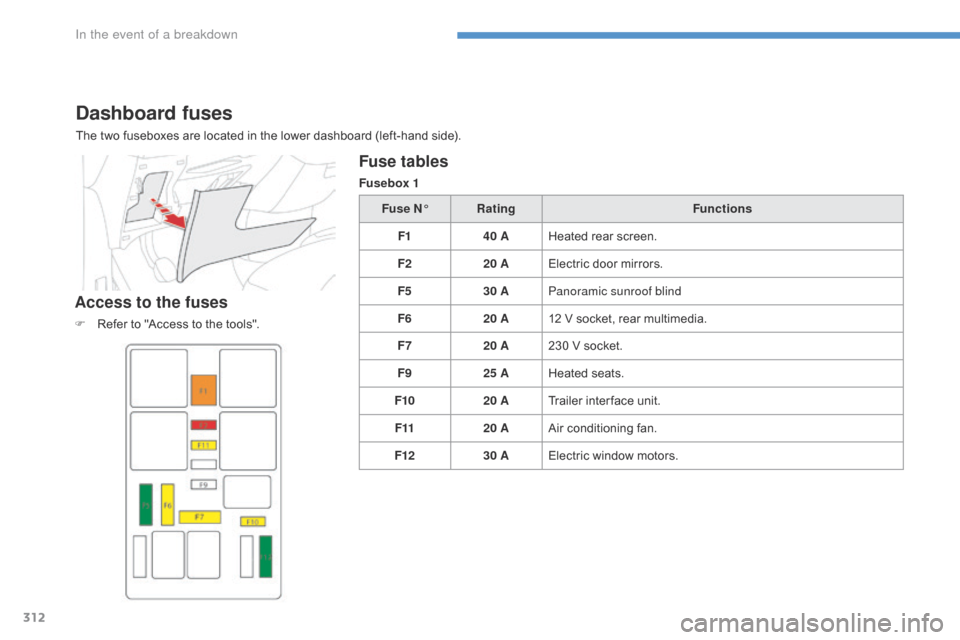
312
C4-Picasso-II_en_Chap08_en-cas-panne_ed01-2016
Dashboard fuses
The two fuseboxes are located in the lower dashboard (left-hand side).
Access to the fuses
F Refer to "Access to the tools".
Fuse tables
Fusebox 1
Fuse N° Rating Functions
F1 40 AHeated
rear screen.
F2 20 AElectric
door mirrors.
F5 30 APanoramic sunroof blind
F6 20 A12 V
socket, rear multimedia.
F7 20 A230
V socket.
F9 25 AHeated
s
eats.
F10 20 ATrailer
inter face unit.
F11 20 AAir
conditioning fan.
F12 30 AElectric
window motors.
In the event of a breakdown
Page 315 of 527
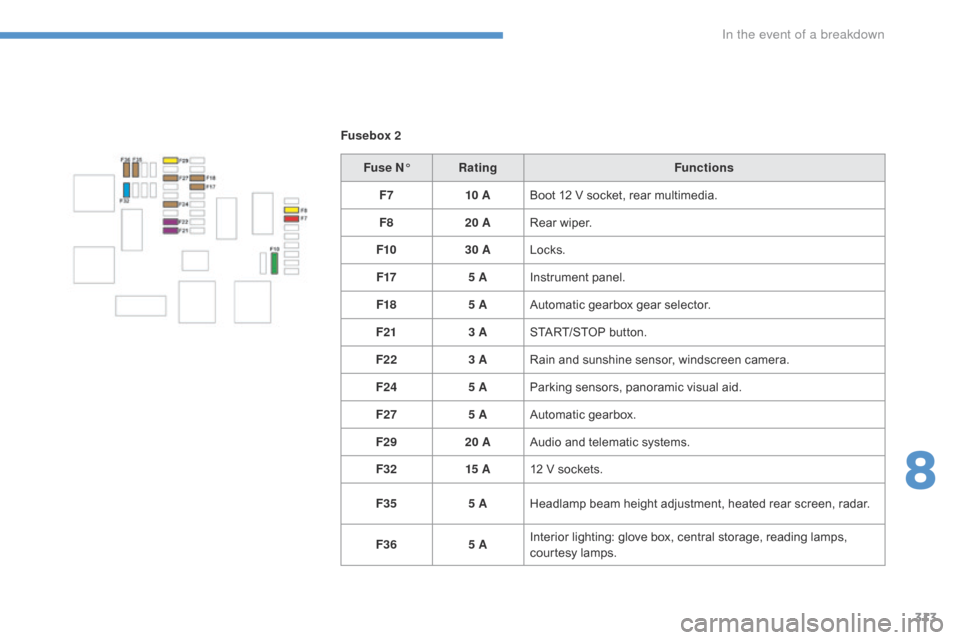
313
C4-Picasso-II_en_Chap08_en-cas-panne_ed01-2016
Fusebox 2Fuse N° Rating Functions
F7 10 ABoot
12 V socket, rear multimedia.
F8 20 ARear
wiper.
F10 30 ALocks.
F17 5 AInstrument
panel.
F18 5 AAutomatic
gearbox gear selector.
F21 3 ASTART/STOP
button.
F22 3 ARain
and sunshine sensor, windscreen camera.
F24 5 AParking
sensors, panoramic visual aid.
F27 5 AAutomatic
gearbox.
F29 20 AAudio
and telematic systems.
F32 15 A12
V sockets.
F35 5 AHeadlamp
beam height adjustment, heated rear screen, radar.
F36 5 AInterior
lighting: glove box, central storage, reading lamps,
c
ourtesy lamps.
8
In the event of a breakdown
Page 316 of 527
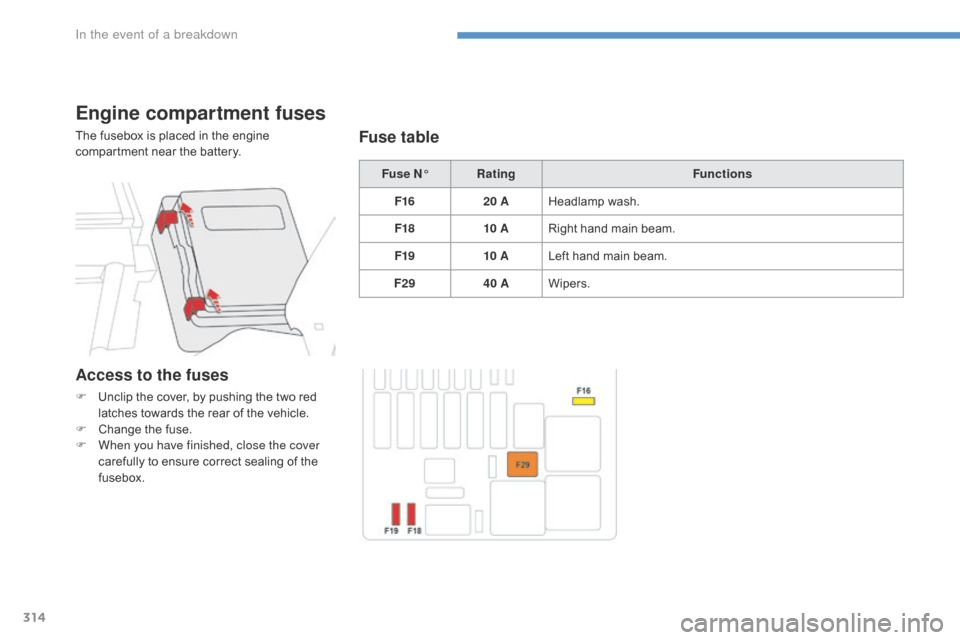
314
C4-Picasso-II_en_Chap08_en-cas-panne_ed01-2016
Engine compartment fuses
The fusebox is placed in the engine compartment near the battery.
Fuse N°Rating Functions
F16 20 AHeadlamp
w
ash.
F18 10 ARight
hand main beam.
F19 10 ALeft
hand main beam.
F29 40 AWipers.Fuse table
Access to the fuses
F Unclip the cover, by pushing the two red l
atches towards the rear of the vehicle.
F
C
hange the fuse.
F
W
hen you have finished, close the cover
carefully
to ensure correct sealing of the
f
usebox.
In the event of a breakdown
Page 317 of 527
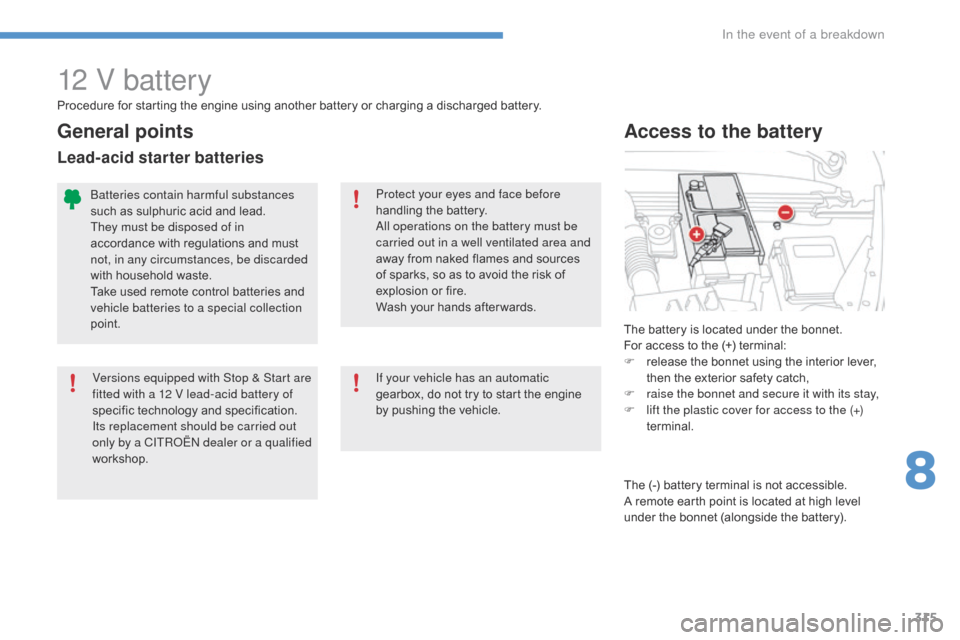
315
C4-Picasso-II_en_Chap08_en-cas-panne_ed01-2016
12 V battery
The battery is located under the bonnet.
F or access to the (+) terminal:
F
r
elease the bonnet using the interior lever,
t
hen the exterior safety catch,
F
r
aise the bonnet and secure it with its stay,
F
l
ift the plastic cover for access to the (+)
terminal.
Access to the battery
Procedure for starting the engine using another battery or charging a discharged battery.
P rotect your eyes and face before
handling
the battery.
All operations on the battery must be
carried out in a well ventilated area and
away
from naked flames and sources
o
f sparks, so as to avoid the risk of
e
xplosion or fire.
Wash
your hands after wards.
Versions equipped with Stop & Start are
fitted with a 12 V lead-acid battery of
specific
t
echnology
a
nd
s
pecification.
Its replacement should be carried out
only by a CITROËN dealer or a qualified
workshop.
Batteries contain harmful substances
such
as sulphuric acid and lead.
They must be disposed of in
accordance
with regulations and must
n
ot, in any circumstances, be discarded
with
household waste.
Take
used remote control batteries and
v
ehicle batteries to a special collection
point.
General points
Lead-acid starter batteries
If your vehicle has an automatic
gearbox, do not try to start the engine
b
y pushing the vehicle.
The
(-) battery terminal is not accessible.
A r
emote earth point is located at high level
u
nder the bonnet (alongside the battery).
8
In the event of a breakdown
Page 318 of 527
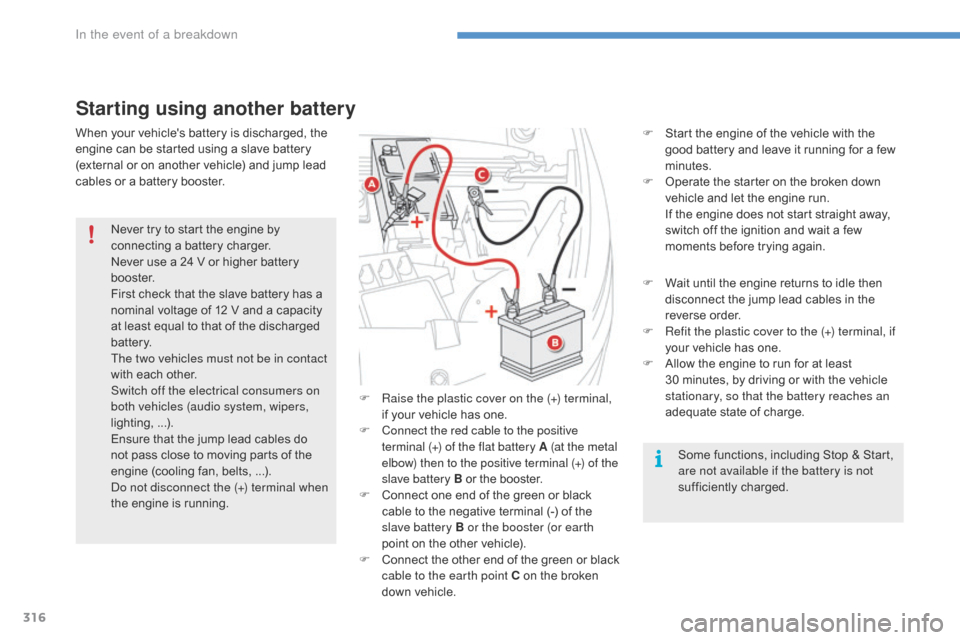
316
C4-Picasso-II_en_Chap08_en-cas-panne_ed01-2016
F Start the engine of the vehicle with the g
ood battery and leave it running for a few
m
inutes.
F
O
perate the starter on the broken down
v
ehicle and let the engine run.
I
f the engine does not start straight away,
s
witch off the ignition and wait a few
m
oments before trying again.
F
W
ait until the engine returns to idle then
d
isconnect the jump lead cables in the
r
everse
o
rder.
F
R
efit the plastic cover to the (+) terminal, if
your
vehicle has one.
F
A
llow the engine to run for at least
3
0 minutes, by driving or with the vehicle
s
tationary, so that the battery reaches an
adequate
state of charge.
Starting using another battery
Some functions, including Stop & Start, are not available if the battery is not
sufficiently
c
harged.
F
R
aise the plastic cover on the (+) terminal,
if
your
vehicle
has
one.
F
C
onnect the red cable to the positive
terminal (+) of the flat battery A (at the metal
elbow) then to the positive terminal
(+) of the
slave battery B
or
the
booster.
F
C
onnect
one
end
of
the
green
or
black
c
able
to
the
negative
terminal
(-)
of
the
s
lave battery B or the booster (or earth
point
on
the
other
vehicle).
F
C
onnect
t
he
o
ther
e
nd
o
f
t
he
g
reen
o
r
b
lack
c
able to the earth point C
on
the
broken
d
own
vehicle.
Never
try
to
start
the
engine
by
c
onnecting
a
battery
charger.
Never
use
a
24
V
or
higher
battery
b
o o s t e r.
First
check
that
the
slave
battery
has
a
n
ominal
voltage
of
12
V
and
a
capacity
a
t
least
equal
to
that
of
the
discharged
b
attery.
The two vehicles must not be in contact
with
each
other.
Switch off the electrical consumers on
both vehicles (audio system, wipers,
lighting, ...).
Ensure
that
the
jump
lead
cables
do
n
ot
pass
close
to
moving
parts
of
the
e
ngine
(cooling
fan,
belts, ...).
Do not disconnect the (+) terminal when
the
engine
is
running.
When
your
vehicle's
battery
is
discharged,
the
e
ngine
can
be
started
using
a
slave
battery
(
external
or
on
another
vehicle)
and
jump
lead
c
ables
or
a
battery
booster.
In the event of a breakdown
Page 319 of 527
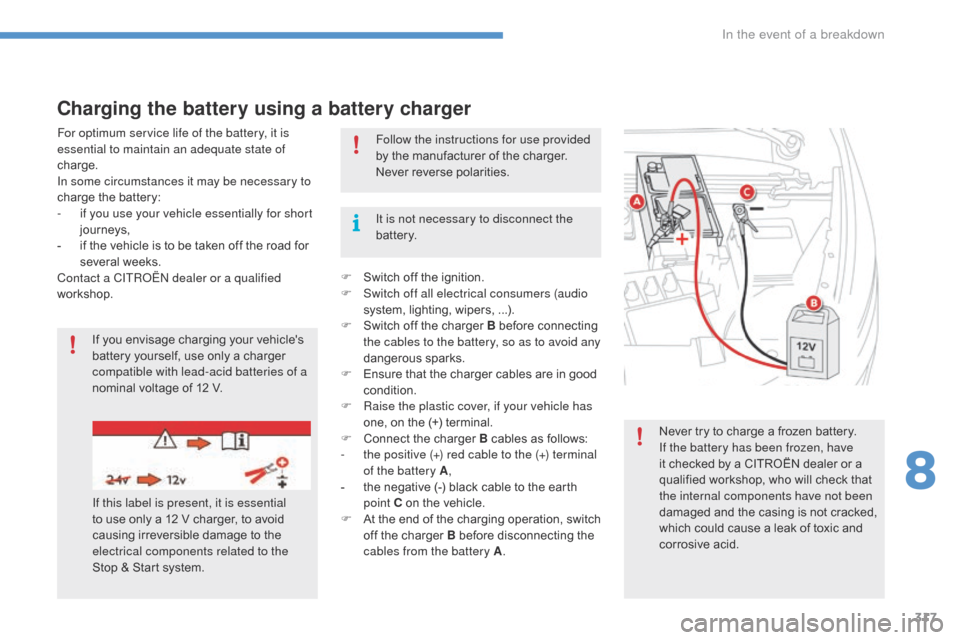
317
C4-Picasso-II_en_Chap08_en-cas-panne_ed01-2016
Never try to charge a frozen battery.
I f the battery has been frozen, have
it
checked by a CITROËN dealer or a
q
ualified workshop, who will check that
t
he internal components have not been
damaged
and the casing is not cracked,
w
hich could cause a leak of toxic and
c
orrosive acid.
F
S
witch
off
the
ignition.
F
S
witch off all electrical consumers (audio
system,
lighting,
wipers, ...).
F
S
witch
off
the
charger
B
before
connecting
t
he cables to the battery, so as to avoid any
dangerous
spar
ks.
F
E
nsure
that
the
charger
cables
are
in
good
c
ondition.
F
R
aise the plastic cover, if your vehicle has
one,
on
the
(+)
terminal.
F
C
onnect
the
charger
B
cables
as
follows:
-
t
he positive (+) red cable to the (+) terminal
of the battery A ,
-
t
he
negative
(-)
black
cable
to
the
earth
p
oint C
on
the
vehicle.
F
A
t
the
end
of
the
charging
operation,
switch
o
ff
the
charger
B
before
disconnecting
the
c
ables from the battery A .
It is not necessary to disconnect the
battery.
If
you
envisage
charging
your
vehicle's
b
attery
yourself,
use
only
a
charger
c
ompatible with lead-acid batteries of a
nominal
voltage
of
12
V. Follow the instructions for use provided
by
the
manufacturer
of
the
charger.
Never
reverse
polarities.
Charging the battery using a battery charger
If this label is present, it is essential
to
use only a 12 V charger, to avoid
c
ausing irreversible damage to the
el
ectrical components related to the
Stop
& Start system.
For optimum service life of the battery, it is
essential to maintain an adequate state of
charge.
In some circumstances it may be necessary to
charge
the battery:
-
i
f you use your vehicle essentially for short
journeys,
-
i
f
the vehicle is to be taken off the road for
s
everal weeks.
Contact a CITROËN dealer or a qualified
workshop.
8
In the event of a breakdown
Page 320 of 527

318
C4-Picasso-II_en_Chap08_en-cas-panne_ed01-2016
The Stop & Start system may not be
operational during the trip following the
f
irst engine start.
In this case, the system will only be
available
again after a continuous
p
eriod of immobilisation of the vehicle,
a period which depends on the ambient
temperature
and the state of charge of
t
he battery (up to about 8 hours).
Do
not
force
the
lever
as
locking
will
n
ot be possible if the clamp is not
positioned
correctly;
start
the
procedure
ag
ain.
Disconnecting the (+) terminal
F
Ra
ise the lever A fully to release the
clamp
B
.
Reconnecting the (+) terminal
F
P
osition the open clamp B of the cable on
the
positive
post
(+)
of
the
battery.
F
P
ress down on the clamp to position it
correctly
on
the
battery
post.
F
L
ock
the
clamp
by
lowering
the
lever
A .
Disconnecting the battery
In order to maintain an adequate state
of
charge for starting the engine, it is
r
ecommended that the battery be disconnected
if
the vehicle is taken out of service for a long
p
eriod.
Before
disconnecting the battery:
F
c
lose all openings (doors, boot, windows,
r
oof),
F
s
witch off all electrical consumers (audio
system,
wipers, lighting, ...),
F
s
witch off the ignition and wait for four
m
inutes.
At
the battery, detach just the (+) terminal.Following reconnection of the battery
Following reconnection of the battery, switch on the ignition and wait 1 minute before starting to
p
ermit initialisation of the electronic systems.
H
owever, if problems remain following this
o
peration, contact a CITROËN dealer or a
qualified
w
orkshop.
Referring
to the corresponding section, you
m
ust
y
ourself
r
einitialise
(
depending
o
n
ve
rsion):
-
t
he remote control key,
-
t
he electric blind(s),
-
...
Quick release terminal
In the event of a breakdown